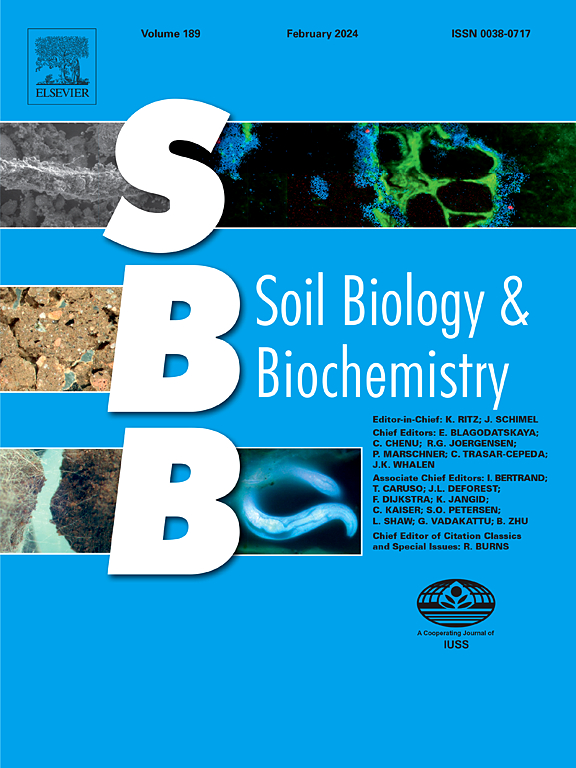Microbial starch degradation in arid soil: Community dynamics, environmental influences, and archaeological implications
IF 9.8
1区 农林科学
Q1 SOIL SCIENCE
引用次数: 0
Abstract
Starch is the primary energy storage compound in plants, and the most important carbohydrate in the human diet. Intact starch granules have been found in archaeological contexts, suggesting that starch may be recalcitrant to degradation in certain conditions. We identified microbial communities that degraded tuber starch in arid soils from Oldupai Gorge, Tanzania, and assessed their dependence on moisture, O2, and starch purity. Laboratory soil microcosms were amended with ground native Ipomoea longituba tubers or purified starch from Solanum tuberosum (common potato), which both contain starches of B-type crystallinity. Sequencing of 16S rRNA and 18S rRNA genes, DNA-stable isotope probing with 13C labelled starch, and metagenomic analysis of amylases all indicated that starch was metabolised by diverse bacteria belonging mostly to the phyla Actinomycetota and Bacillota (Firmicutes), and by Ascomycota fungi. Some of the starch-degrading Actinomycetota were also enriched in the rhizosphere of field Ipomoea longituba plants. Some microbes responded to both substrates, while others responded only to one. Members of the genus Streptomyces were stimulated by potato starch but not Ipomoea longituba tuber material, while members of the genus Bacillus were stimulated by Ipomoea longituba tuber but not potato starch. The use of purified starch in experiments therefore did not fully reproduce the complex interactions between plant-derived starch and soil microbial communities. Although starch purity, soil moisture and pO2, and microbial community all affected starch metabolism, visible starch granules were always rapidly destroyed, even when subsequent respiration of the starch material was severely limited. Native Ipomoea longituba starch granules were destroyed within a few days in all treatments. Our results therefore suggest that long-term preservation of native, unmodified starch granules in soils over long time periods is unlikely even under very harsh conditions. These results provide some guidance for designing future studies into starch preservation mechanisms.

干旱土壤中的微生物淀粉降解:群落动态、环境影响和考古意义
淀粉是植物主要的能量储存化合物,也是人类饮食中最重要的碳水化合物。在考古环境中发现了完整的淀粉颗粒,这表明淀粉在某些条件下可能难以降解。我们鉴定了在坦桑尼亚Oldupai峡谷干旱土壤中降解块茎淀粉的微生物群落,并评估了它们对水分、氧气和淀粉纯度的依赖。在实验室土壤微观环境中,用本地马铃薯马铃薯块茎或马铃薯马铃薯纯化淀粉进行改良,两者均含有b型结晶度淀粉。16S rRNA和18S rRNA基因的测序、13C标记淀粉的dna稳定同位素探测以及淀粉酶的宏基因组分析都表明,淀粉主要由放线菌门和芽孢杆菌门(厚壁菌门)以及子囊菌门真菌等多种细菌代谢。部分淀粉降解放线菌群也富集于大田纵薯蓣根际。一些微生物对两种底物都有反应,而另一些只对一种底物有反应。Streptomyces属的成员受到马铃薯淀粉的刺激,而不是马铃薯块茎材料,芽孢杆菌属成员受到马铃薯块茎而不是马铃薯淀粉的刺激。因此,在实验中使用纯化淀粉并不能完全再现植物淀粉与土壤微生物群落之间复杂的相互作用。虽然淀粉纯度、土壤水分和pO2以及微生物群落都影响淀粉代谢,但可见淀粉颗粒总是迅速被破坏,即使淀粉物质的后续呼吸受到严重限制。所有处理均可在数天内破坏原生纵木芋淀粉颗粒。因此,我们的研究结果表明,即使在非常恶劣的条件下,长期保存原生的、未改性的淀粉颗粒在土壤中也是不可能的。这些结果为今后淀粉保存机制的研究提供了一定的指导。
本文章由计算机程序翻译,如有差异,请以英文原文为准。
求助全文
约1分钟内获得全文
求助全文
来源期刊

Soil Biology & Biochemistry
农林科学-土壤科学
CiteScore
16.90
自引率
9.30%
发文量
312
审稿时长
49 days
期刊介绍:
Soil Biology & Biochemistry publishes original research articles of international significance focusing on biological processes in soil and their applications to soil and environmental quality. Major topics include the ecology and biochemical processes of soil organisms, their effects on the environment, and interactions with plants. The journal also welcomes state-of-the-art reviews and discussions on contemporary research in soil biology and biochemistry.
 求助内容:
求助内容: 应助结果提醒方式:
应助结果提醒方式:


